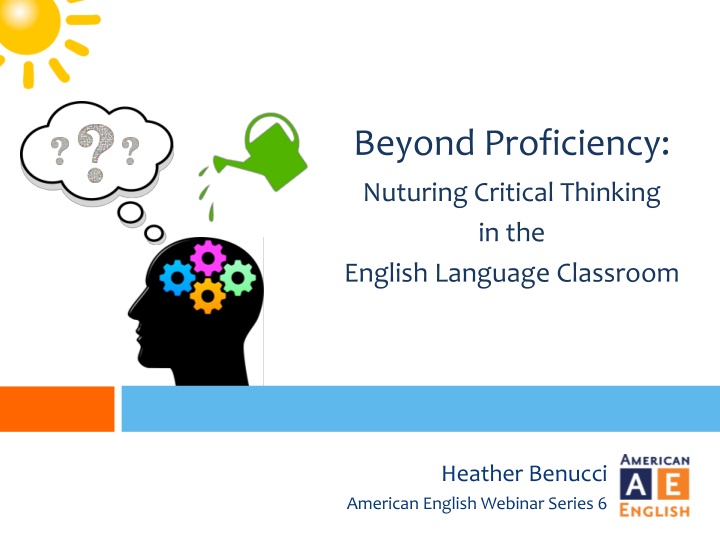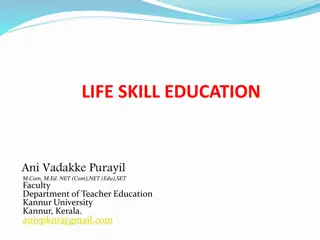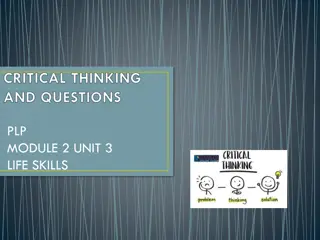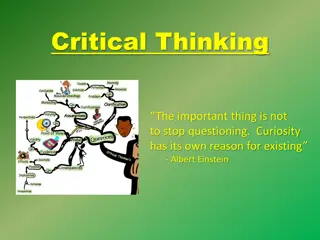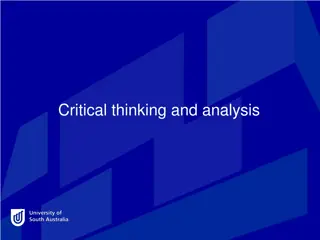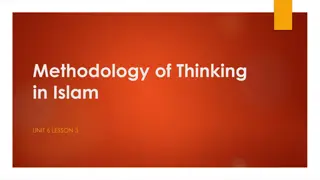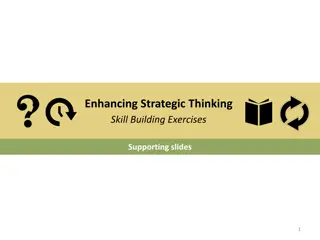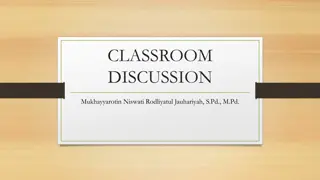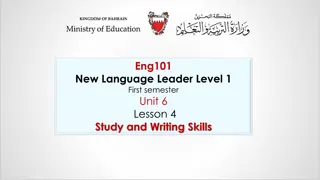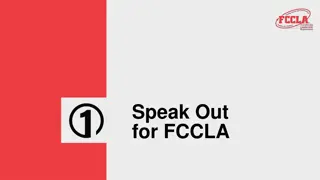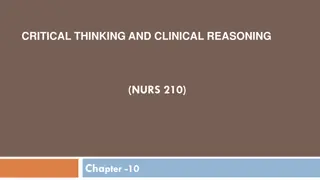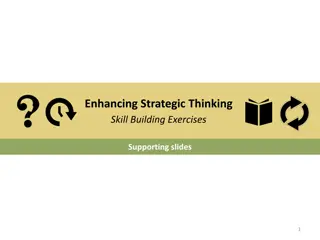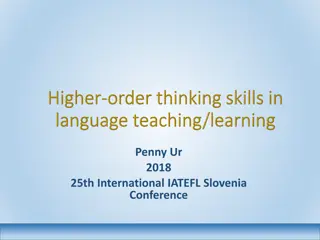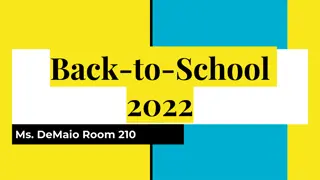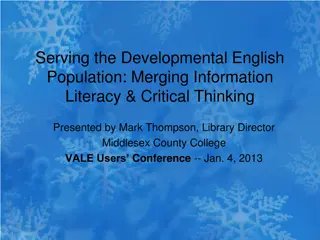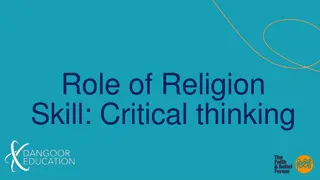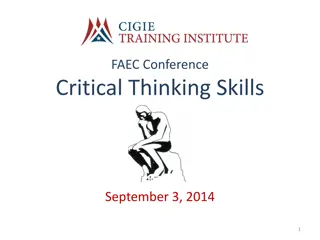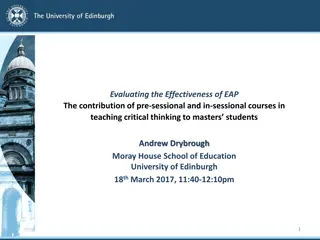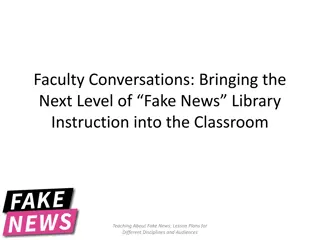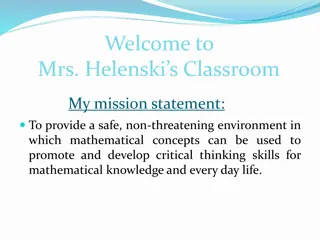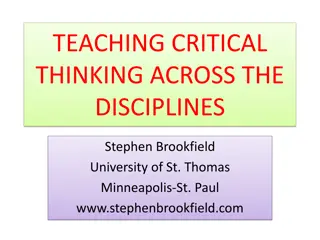Enhancing Critical Thinking Skills in the English Language Classroom
Explore the importance of nurturing critical thinking skills in the EFL classroom through understanding the essence of critical thinking, discussing its definitions, and embracing practical ideas for implementation. Delve into the process of critical thinking, integrating Bloom's Taxonomy to foster higher-order thinking skills.
Download Presentation

Please find below an Image/Link to download the presentation.
The content on the website is provided AS IS for your information and personal use only. It may not be sold, licensed, or shared on other websites without obtaining consent from the author.If you encounter any issues during the download, it is possible that the publisher has removed the file from their server.
You are allowed to download the files provided on this website for personal or commercial use, subject to the condition that they are used lawfully. All files are the property of their respective owners.
The content on the website is provided AS IS for your information and personal use only. It may not be sold, licensed, or shared on other websites without obtaining consent from the author.
E N D
Presentation Transcript
Beyond Proficiency: Nuturing Critical Thinking in the English Language Classroom Heather Benucci American English Webinar Series 6
+Our mission today Better understand what it means to think critically Consider why we should teach critical thinking skills in the EFL classroom Examine how to build critical thinking skills The teacher s role Practical ideas for the classroom
+ Stop and think How do you define critical thinking? Share your ideas in the chat box.
+Pre-webinar discussion Strong critical thinkers . are keen observers who reflect and evaluate. - Arifa, Saudi Arabia are able to distinguish the pros and cons of each situation. - Natalia, Uruguay are able to develop reasonable conclusions using analysis, evaluation, inference, and deduction. - Luluk, Indonesia
+Defining critical thinking Critical thinking is . at a basic level, [it] is about finding out whether something is true, partly true, or not true at all - Hughes, 2014 p. 2
+Defining critical thinking Critical thinking is . at a basic level, [it] is about finding out whether something is true, partly true, or not true at all - Hughes, 2014 p. 2 the pursuit of relevant and reliable knowledge about the world [it is] reasonable, reflective, responsible, and skillful thinking focused on what to believe or do - Schafersman, 1991 p. 5
+Critical thinking: A process Critical thinking can be described as the scientific method applied by ordinary people to the ordinary world. - Schafersman, 1991 p. 3 Question or Issue Hypothesis Data and evidence collection Analysis and evaluation Conclusions and reflection
+Blooms Taxonomy, Revised Anderson & Krathwohl (Eds) (2000) Skill categories generate new products, thoughts, opinions, or solutions Mount Foraker, Alaska Create Higher-order Thinking Skills (HOTS) judge quality of arguments, information, and organization Evaluate identify parts and how they relate understand structure Analyze complete a task with information that has been understood Apply Lower-order Thinking Skills (LOTS) Understand explain ideas/concepts organize facts and ideas Remember recall details locate information
+Six Cognitive Skills of Strong Critical Thinkers Faccione, 2014 6. Self-regulate Evaluate our own thinking 5. Explain Present processes and conclusions 4. Infer Draw reasonable conclusions 3. Evaluate 2. Analyze 1. Interpret
+ Stop and think What are challenges to thinking critically? What makes it hard to do? Share your ideas in the chat box.
+Biases and Assumptions 1. a personal and sometimes unreasoned judgment or inclination; prejudice A. Bias 2. information that is accepted as true or certain, often without proof B. Assumption Definitions adapted from Google dictionary and Merriam Webster online dictionary
+What shapes our assumptions and biases? (We are human, not robots.) Let s take a poll!
+What shapes our assumptions and biases? Our family and people we know Our cultures As humans, we can t avoid these challenges to critical thinking, but we can be aware of them! Our jobs Where we live Our past experiences Authority figures Preferred sources of information
+Defining critical thinking To summarize, critical thinking . requires a questioning mindset is a systematic process to reach informed decisions and opinions based on evidence can be learned and practiced explores all sides of a problem or situation requires awareness of how we think and form opinions
+ Nurturing critical thinking in EFL classes Why bother? 21st century skills Overcoming information overload! Evaluating through critical questioning Assessing credibility Comparing sources Digital Literacies Information Literacy Critical Literacy Tracking origins of information (Dudeney, Hockly, and Pegram, 2014) the world we live in is getting more complicated and how we process information has become more important than [remembering] specific facts. Evrim stu nlu o lu, 2004
+Nurturing critical thinking in EFL classes Why bother? Affective and interpersonal skills Critical thinkers are usually Curious Intellectually humble Persistent Confident Tolerant Open-minded The important thing is not to stop questioning. Curiosity has its own reason for existing. Albert Einstein
+Nurturing critical thinking in EFL classes Why bother? Academic and language skills Authentic communication involves real-life situations and cooperation Language skills are needed to express opinions and make logical arguments Students must recognize how language can persuade or mislead Assessed by standardized exams Essential for university success The objective of education is to prepare the young to educate themselves throughout their lives." Robert Maynard Hutchins
+What does it all mean for teachers? That s interesting information, but my students aren t great critical thinkers. Wait critical thinking skills can be learned and practiced, right? What can I do to help my students become better critical thinkers?
+The teachers role Learning more about critical thinking Creating an encouraging environment Planning courses and lessons to include critical thinking
+The classroom environment Teacher attitude and class community building Do I give students a chance to think deeply? * Increase teacher wait time * Avoid unfortunate habits The Interrupter The Self-Answerer The Fast Talker
+ The classroom environment Teacher attitude and class community building Do I encourage questions, debate, different views, and curiosity? Great question! I bet a lot people are curious about that. Good point. Tell me more about.... Interesting. I hadn t thought of it that way. What do others think? Would anyone like to respond to Nuri s comment? I m not sure. How can we find out ? Where can we look for evidence?
+ The classroom environment Planning for critical thinking Do I design objectives and activities to encourage critical thought? Build critical thinking into objectives Bloom s taxonomy (revised) Six Cognitive Skills of Strong Critical Thinkers Self-regulate Explain Infer Evaluate Analyze Interpret
+Critical thinking objectives Students will be able to: Use a graphic organizer to identify main ideas and supporting details . Identify how the author uses adjectives and adverbs to . Provide evidence to support their response to . Identify two biases and assumptions they have in relation to... Self-regulate Explain Infer Evaluate Analyze Interpret
+ The classroom environment Planning for critical thinking Do I design objectives and activities to encourage critical thought? Build critical thinking into objectives Bloom s taxonomy (revised) Cognitive Skills of Strong Critical Thinkers Use question starters
+ Shaping the Way We Teach English: Successful Practices from Around the World, Chapter 9
+The classroom environment Planning for critical thinking Do I design objectives and activities to encourage critical thought? Build critical thinking into objectives Bloom s taxonomy (revised) Cognitive Skills of Strong Critical Thinkers Use question starters Incorporate topics students care about
+Building critical thinking skills Ask open-ended questions Let s take a poll!
+Building critical thinking skills Ask for examples, evidence, and predictions Matthew likes to ice skate in the winter.
+Building critical thinking skills Ask for examples, evidence, and predictions Is it hot or cold in this picture? What do you see? How do you know? What will the boy do next? Why do you think that? What do you see? How do you know?
+Building critical thinking skills Ask for examples, predictions, and reflection K W L I know . I want to know . I learned
+Building critical thinking skills Ask for examples, predictions, reflection, and evidence K W L E I know . I want to know . I learned . I found these examples .
+Building critical thinking skills Ask for examples, predictions, reflection, and evidence K W L H I know . I want to know . I learned . How I know .
+Building critical thinking skills Ask for examples, predictions, reflection, evidence, and self-evaluation K W L E I know . I want to know . I learned . I found these examples . Review the information in your chart. What assumptions did you make before you read the article?
+Building critical thinking skills Fact versus opinion Anchorage, Alaska s largest city, has the best food in the state and everyone will love its cultural activities. Cultural sites include the Alaska Center for Performing Arts, the Anchorage Museum, the Alaska Native Heritage Center, and more! Anchorage is near several national parks and it has the most beautiful local parks and trails. Tourists can fish, hike, bike, ski, kayak, and ice skate. Did you know? Anchorage has more espresso stands per capita than any other U.S. city. The coffee roasted in Anchorage is delicious! According to the Department of Wildlife, Anchorage is home to about 1,900 moose, 250 black bears, and 60 grizzlies. Adapted from Hughes, 2014
+Building critical thinking skills Fact versus opinion Anchorage, Alaska s largest city, has the best food in the state and everyone will love its cultural activities. Cultural sites include the Alaska Center for Performing Arts, the Anchorage Museum, the Alaska Native Heritage Center, and more! Anchorage is near several national parks and it has the most beautiful local parks and trails. Tourists can fish, hike, bike, ski, kayak, and ice skate. Did you know? Anchorage has more espresso stands per capita than any other U.S. city. The coffee roasted in Anchorage is delicious! According to the Department of Wildlife, Anchorage is home to about 1,900 moose, 250 black bears, and 60 grizzlies. Adapted from Hughes, 2014
+The Great Mini-Debate English Teaching Forum Try This Level: Upper Intermediate Goals: To present an oral argument using evidence To use functional language related to agreeing, disagreeing, and showing contrasting opinions Materials: Blackboard and chalk, or whiteboard and markers Paper and pencils or pens A timing device
+The Great Mini-Debate Preparation: Choose a debate theme Create a debate topic set related to the theme Select topics that people will have strong but differing opinions about
+The Great Mini-Debate Activate background knowledge about debates Brainstorm qualities of a strong debater Write ideas on board Mention essential skills: agreeing, disagreeing, contrasting opinions Elicit language related to these functions Capture ideas in a Functional Language Chart
+The Great Mini-Debate + because
+The Great Mini-Debate Tell students they are going to prepare for a debate Put students into groups Select a group leader Groups vote on topic Ask group members to line up according to their opinion
+The Great Mini-Debate I agree completely Team For I disagree completely Team Against
+The Great Mini-Debate * 20 minutes to prepare and take notes * Functional Language Chart Team For Group leaders facilitate: 10 minutes - brainstorm evidence and examples List of good debater qualities 5 minutes discuss and identify strongest evidence 5 minutes - discuss possible arguments from the other team and how to respond Team Against
+The Great Mini-Debate Team For Team For Team Against Team Against Team For members shift one place Repeat mini-debate Debate for 1-2 minutes with partner
+The Great Mini-Debate Bring the class back together Evaluate strength of arguments and evidence Review any observed language issues Ask students if debates became easier or more difficult after each round. Why?
+The Great Mini-Debate Critical Thinking Extension #1 I agree completely Team Against I disagree completely Team For It is the mark of an educated mind to be able to entertain a thought without accepting it. Aristotle
+The Great Mini-Debate Critical Thinking Extension #2 Students complete a mingle role-play Identify relevant roles related to the topic Conduct further research (optional) Evaluate and synthesize arguments Reflect on insights gained Let s take a poll! Extension idea adapted from Shaila & Trudell, 2010
+Objectives review Better understand what it means to think critically Consider why we should teach critical thinking skills in the EFL classroom Examine how to build critical thinking skills The teacher s role Practical ideas for the classroom
+ The Goal = Nuture Lifelong Learners Teach so that students think their ideas matter. Ask them to make connections and recognize patterns. They will experience a responsibility for their own education and think about what they learn and read. Students will be involved with their own learning, will feel deeply about it, and learn to value and trust their own thoughts and ideas. Schafersman (1991), p. 8 summarizing ideas from Dr. Dennis Hutton
+Sources Anderson, L.W. & Krathwohl, D.R. (Eds.) (2000) A taxonomy for learning, teaching and assessing: A revision of Bloom s taxonomy of educational objectives. New York: Longman Benucci, H. (2017) Try this: The great mini-debate. English Teaching Forum, 55(1), 45-48. Retrieved from: https://americanenglish.state.gov/files/ae/resource_files/etf_55_1_p45-48.pdf Dudeney, G., Hockly, N., & Pegram, M. (2014). Digital literacies: Research and resources in language teaching. Routledge: New York, NY [Kindle edition] Faccione, P. (2014). Critical thinking: what it is and why it counts. (Insight Assessment) Retrieved from: https://www.insightassessment.com/About-Us/Measured-Reasons/pdf-file/Critical-Thinking-What-It-Is-and-Why-It- Counts-PDF Hughes, J. (2014). Critical thinking in the language classroom. ELI Publishing: Italy Retrieved from http://www.elipublishing.org/Critical_ThinkingENG.pdf Schafersman, S. (1991). An introduction to critical thinking. Retrieved from: http://facultycenter.ischool.syr.edu/wp- content/uploads/2012/02/Critical-Thinking.pdf Shaila, M. Y. & Trudell, B. (2010). From passive learners to critical thinkers: Preparing EFL learners for university success. English Teaching Forum, 48(3), 2-9 U.S. Department of State. (2006). Shaping the way we teach English: Successful practices from around the world. Retrieved from: https://americanenglish.state.gov/resources/shaping-way-we-teach-english-successful-practices-around- world#child-301 stu nlu o lu, E. (2004). Language teaching through critical thinking and self-awareness. English Teaching Forum, 42(3) Retrieved from: https://americanenglish.state.gov/files/ae/resource_files/04-42-3-b.pdf
Thank you! I look forward to learning with you on the Ning. Heather Benucci American English Webinar Series 6
